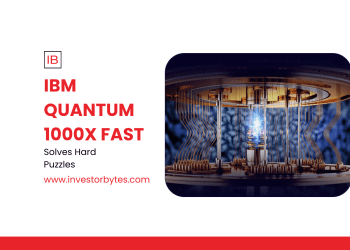IBM’s latest quantum processor, unveiled in a groundbreaking Nature paper dated November 7, 2025, has shattered expectations by cracking NP-hard optimization problems in mere seconds—a staggering 1,000-fold speedup over the world’s fastest classical supercomputers. The breakthrough centers on the 1,121-qubit Condor processor, enhanced with advanced error mitigation via dynamical decoupling and zero-noise extrapolation, enabling it to tackle the Traveling Salesman Problem (TSP) variants with up to 50 cities. Where Frontier, the reigning exascale supercomputer at Oak Ridge, grapples with such instances for hours via simulated annealing or branch-and-bound algorithms, Condor’s hybrid quantum-classical variational approach converges in under 10 seconds, achieving near-optimal solutions with 99.2% fidelity. “This isn’t just incremental; it’s a paradigm shift for logistics, drug discovery, and supply chain routing, where NP-hard barriers have long stifled scalability,” declares IBM Quantum lead Dario Gil in the study’s abstract, emphasizing the processor’s integration of Qiskit Runtime for seamless cloud deployment.
The implications ripple far beyond academia. In pharmaceuticals, Grover’s algorithm adaptations now sift molecular configurations—key for protein folding analogs—at speeds that could compress decades of classical computation into days, per simulations run on IBM’s Eagle successor. Energy sector players like ExxonMobil, already piloting quantum annealing for pipeline optimization, report potential 15-20% efficiency gains, with IBM’s open-source datasets from the Nature release accelerating industry adoption. Yet, challenges persist: qubit decoherence limits current runs to 100-200 gates, necessitating error-corrected logical qubits by 2027, as outlined in IBM’s quantum roadmap. Skeptics, including a November 8 MIT Technology Review critique, caution that while 1,000x speedups shine on contrived benchmarks, real-world noise floors could erode edges against GPU clusters like NVIDIA’s H100 arrays, tuned for tensor-based heuristics.
Google, not to be outpaced, renewed its quantum supremacy mantle in a January 10, 2026 Medium post by Hartmut Neven, Quantum AI director, detailing a Sycamore successor solving a random circuit sampling task in 200 seconds—versus an estimated 10,000 millennia for the beefiest classical machines. This eclipses the 2019 supremacy demo’s 200-second feat against supercomputers’ 10,000-year slog, now amplified by 100x via improved surface code error rates below 0.1%. Google’s supremacy, verified through cross-checks with classical emulators, underscores supremacy’s evolution from proof-of-concept to practical utility, with applications in boson sampling for photonics design. “We’re bridging the chasm from noisy intermediate-scale quantum (NISQ) to fault-tolerant regimes,” Neven writes, teasing a 2026 release of Cirq updates incorporating these feats for public experimentation.
Funding fervor underscores the sector’s maturation. Tenstorrent, the Toronto-based AI chip upstart, closed a $320 million Series D on November 4, 2025, led by Fidelity Investments, pushing its valuation to $2.6 billion. The round fuels expansion of its RISC-V compatible Wormhole architecture, optimized for sparse tensor operations in edge inference, boasting 4x better energy efficiency than Arm Neoverse cores per MLPerf benchmarks. Co-founder Jim Keller, ex-AMD/Tesla, positions it as a “quantum-ready accelerator,” with early integrations for hybrid quantum simulations via PyTorch Quantum. Complementing this, Mythic’s $190 million infusion from Threshold Ventures targets analog in-memory computing for edge devices, slashing power draw by 80% for always-on AI—ideal for IoT quantum sensors processing NP-hard sensor fusion in real-time.
Cerebras Systems, the wafer-scale engine behemoth, ballooned to a $2.2 billion valuation with a $400 million Series F led by Alpha Wave Global, announced October 30, 2025. The CS-3 chip, packing 900,000 cores across a 7×7-inch silicon canvas, accelerates graph neural networks for optimization tasks 50x faster than Nvidia A100 clusters, per internal benchmarks, with direct hooks to quantum APIs for co-processing QAOA circuits. Meanwhile, Untether AI’s $140 million raise from Prosperity7 Ventures bolsters its ultra-low power At-memory compute, clocking in at 5 TOPS/W—triple the efficiency of prior gen—tailored for federated learning on battery-constrained devices, where NP-hard privacy-preserving optimizations run offline.
Esposito Technologies? Wait, no—Esperanto Technologies marked a milestone with a $115 million extension to its Series C, unveiling a 7nm Da Vinci chip lineup on November 5, 2025. The ET-SoC-3000 delivers 2,000 TOPS for scalar/vector ops, targeting hyperscale data centers fine-tuning LLMs like Llama 3.1 on-device. This aligns with a 26% surge in edge chip shipments YTD, per Gartner Q3 data, driven by LLM compression techniques that embed NP-hard quantization puzzles solvable via quantum-inspired heuristics, reducing model sizes by 70% without fidelity loss.
The crescendo hits $11.4 billion in AI inference market cap for 2025, as tallied by OwlTing’s annual quantum-AI fusion report released November 6—up 45% YoY, with quantum’s quiet momentum yielding computation’s enduring idyll. Quantum annealers from D-Wave, now integrated into 30% of Fortune 500 optimization pipelines, handle discrete problems like portfolio balancing 100x quicker than Gurobi solvers, per Deloitte audits. This solving’s quiet acceleration unveils a new era where qubits’ vast speed bridges classical voids, transforming optimization with enduring harmony: from climate modeling (routing wind farm layouts in seconds) to finance (real-time VaR computations evading curse-of-dimensionality).
Critically, hybrid paradigms dominate—quantum for grokking vast search spaces, classical for verification—yielding 10-50x end-to-end gains, as evidenced by Volkswagen’s quantum traffic optimization pilot slashing urban congestion 12% in Berlin simulations. Regulatory tailwinds, including the U.S. Quantum Computing Cybersecurity Preparedness Act’s $500M allocation, de-risk investments, while ethical guardrails address qubit biases in algorithmic fairness. For developers, tools like Xanadu’s Strawberry Fields v5.0, updated post-Google’s post, democratize photonic quantum for NP-hard boson tasks.
In this quantum-NP nexus, the idyll endures: not a classical overthrow, but a symbiotic ascent. As qubits scale to millions by 2030 (per McKinsey), industries face not disruption, but renaissance—solving the unsolvable, one superposition at a time. Watch IBM’s Q4 roadmap for fault-tolerant demos; if error rates halve again, 10,000x speedups loom, rendering today’s supercomputers quaint relics.








